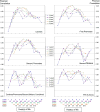Timing of fluoride intake and dental fluorosis on late-erupting permanent teeth
- PMID: 26198477
- PMCID: PMC4718784
- DOI: 10.1111/cdoe.12187
Timing of fluoride intake and dental fluorosis on late-erupting permanent teeth
Abstract
Objective: Very few studies have examined the relationship between timing of fluoride intake and development of dental fluorosis on late-erupting permanent teeth using period-specific fluoride intake information. This study examined this relationship using longitudinal fluoride intake information from the Iowa Fluoride Study.
Methods: Participants' fluoride exposure and intake (birth to 10 years of age) from water, beverages, selected food products, dietary fluoride supplements, and fluoride toothpaste was collected using questionnaires sent to parents at 3- and 4- month intervals from birth to 48 months of age and every 6 months thereafter. Three trained and calibrated examiners used the Fluorosis Risk Index (FRI) categories to assess 16 late-erupting teeth among 465 study participants. A tooth was defined as having definitive fluorosis if any of the zones on that tooth had an FRI score of 2 or 3. Participants with questionable fluorosis were excluded from analyses. Descriptive and logistic regression analyses were performed to assess the importance of fluoride intake during different time periods.
Results: Most dental fluorosis in the study population was mild, with only four subjects (1%) having severe fluorosis (FRI Score 3). The overall prevalence of dental fluorosis was 27.8%. Logistic regression analyses showed that fluoride intake from each of the individual years from age 2 to 8 plays an important role in determining the risk of dental fluorosis for most late-erupting permanent teeth. The strongest association for fluorosis on the late-erupting permanent teeth was with fluoride intake during the sixth year of life.
Conclusion: Late-erupting teeth may be susceptible to fluorosis for an extended period from about age 2 to 8. Although not as visually prominent as the maxillary central incisors, some of the late-erupting teeth are esthetically important and this should be taken into consideration when making recommendations about dosing of fluoride intake.
Keywords: dental fluorosis; fluoride; fluoride intake; late-erupting permanent teeth.
© 2015 John Wiley & Sons A/S. Published by John Wiley & Sons Ltd.
Figures

References
-
- Burt BA. The changing patterns of systemic fluoride intake. J Dent Res. 1992;71:1228–37. - PubMed
-
- Pendrys DG, Stamm JW. Relationship of total fluoride intake to beneficial effects and enamel fluorosis. J Dent Res. 1990;69:556–7. - PubMed
-
- Beltran-Aguilar ED, Griffin SO, Lockwood SA. Prevalence and trends in enamel fluorosis in the united states from the 1930s to the 1980s. J Am Dent Assoc. 2002;133:157–65. - PubMed
-
- Fejerskov O, Manji F, Baelum V. The nature and mechanisms of dental fluorosis in man. J Dent Res. 1990;69:692–700. - PubMed
Publication types
MeSH terms
Substances
Grants and funding
LinkOut - more resources
Full Text Sources
Other Literature Sources

